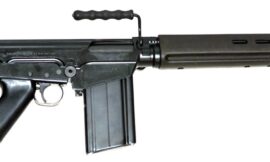The Lee-Enfield is a bolt-action, magazine-fed, repeating rifle that served as the main firearm of the British military and Commonwealth forces from its adoption in 1895 until the mid-20th century. Renowned for its robustness, accuracy, and fast cycling rate, the Lee-Enfield is one of the most iconic and effective rifles in military history.
Historical Background
The Lee-Enfield rifle was developed as a replacement for the earlier Lee-Metford rifle, which had served the British Army since the late 19th century. The primary designer, James Paris Lee, provided the rifle’s bolt system and detachable magazine, while the rifling was designed by the Royal Small Arms Factory at Enfield Lock, hence the name “Lee-Enfield.”
The first version, the Rifle, Magazine, Lee-Enfield, or MLE, was adopted in 1895. This was followed by the Short Magazine Lee-Enfield (SMLE) in 1904, which became the most recognizable and widely used variant.
Design and Features
The Lee-Enfield’s design incorporates several key features that contributed to its long service life and widespread acclaim:
- Bolt-Action Mechanism: The Lee-Enfield uses a rear-locking bolt mechanism that allows for rapid cycling and easy operation. The design enables a trained soldier to fire 15-20 aimed rounds per minute, which is exceptionally fast for a bolt-action rifle.
- 10-Round Magazine: The rifle is equipped with a detachable box magazine that holds ten rounds of .303 British ammunition, double the capacity of most contemporaneous bolt-action rifles. The magazine can be loaded with individual rounds or with five-round stripper clips.
- Rifling: The rifling pattern of the Lee-Enfield provides excellent accuracy and range, with a typical effective range of up to 550 yards (500 meters) for aimed shots and up to 1,000 yards (900 meters) for area suppression.
- Sights: The rifle is equipped with iron sights, adjustable for windage and elevation. Some models also feature aperture rear sights, improving accuracy over longer distances.
- Ergonomics: The Lee-Enfield’s stock and grip design offer comfortable handling and a stable shooting platform. The rifle’s balance and weight distribution make it easier to aim and fire accurately.
- Durability: Constructed from high-quality materials, the Lee-Enfield is known for its ruggedness and ability to function reliably in various environmental conditions, from the deserts of North Africa to the jungles of Southeast Asia.
Variants
Several variants of the Lee-Enfield were produced, each tailored to different operational needs:
- SMLE Mk III: Introduced in 1907, this was the standard British infantry rifle during World War I. It featured a simplified design for easier mass production and a bayonet mount.
- No. 4 Mk I: Developed during World War II, the No. 4 was a simplified and strengthened version of the SMLE, featuring a heavier barrel and improved sights.
- No. 5 Mk I (Jungle Carbine): A shorter and lighter version designed for use in dense jungle environments. It featured a flash suppressor and a rubber butt pad to mitigate recoil.
- Sniper Variants: The Lee-Enfield was adapted into several sniper configurations, such as the No. 4 Mk I (T), equipped with telescopic sights and capable of highly accurate long-range fire.
- Ishapore 2A/2A1: A post-independence Indian variant chambered for 7.62×51mm NATO ammunition, produced at the Ishapore Rifle Factory.
Military Use
The Lee-Enfield rifle saw extensive service in both World Wars and numerous other conflicts:
- World War I: The SMLE Mk III was the primary rifle for British and Commonwealth forces. Its rapid rate of fire and accuracy made it particularly effective in the trench warfare of the Western Front.
- World War II: The No. 4 Mk I became the standard rifle for British forces, serving in all theaters of the war. Its robust design and reliability were highly valued in the diverse environments where it was deployed.
- Post-War Conflicts: The Lee-Enfield continued to see service in various post-war conflicts, including the Korean War, the Malayan Emergency, and the early stages of the Vietnam War. It was also used by numerous colonial and newly independent nations.
- Police and Civilian Use: Beyond military use, the Lee-Enfield has been employed by police forces and civilian shooters around the world due to its reliability and accuracy.
Performance
The Lee-Enfield’s performance is characterized by its balance of accuracy,


